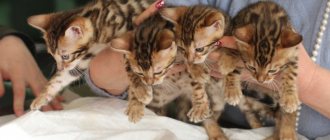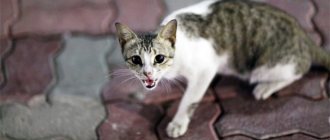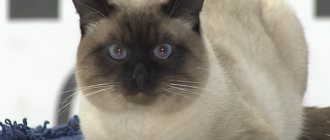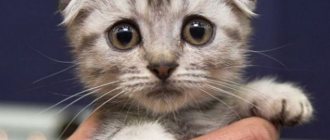Unlike dogs, mustachioed pets take much less time from their owners to care for, because they do not need to be walked and trained. Combined with the high cost of kittens, this fact often encourages cat lovers to open their own business.
In fact, there are pitfalls both here and there, so first you should carefully study all the basics and assess the possible risks. Below you can find out how to start breeding cats from scratch and how profitable it is.
Where to start breeding cats
Breeding cats is the same type of business as trade, provision of services for transporting people or goods, and many others. And before you start it, you need to decide on your goals, costs and capabilities.
The following thoughts usually push people to start this activity:
- Breeding will bring sufficient profit. Usually these are the owners of a purebred animal. Having purchased it for a sufficiently large fee, they decide to recoup the costs.
- I would like to give my cat the opportunity to give birth. Many owners mistakenly believe that the female must give birth once or twice and then she will calm down and will not demand a cat.
- Pedigree breeding will help develop a new breed or improve an existing one. Amateurs are not bothered by such problems. Those who decide to do this are most likely real professionals.
If the decision to breed cats is supported by a clearly justified goal, then it is necessary to estimate the upcoming costs.
Mr. Cat Recommends: Basic Costs
It is strictly not recommended to breed cats in a city apartment. In extreme cases, it can be one couple, but even then you need a separate equipped room, at least an insulated balcony. If a pregnant and then nursing cat can be accommodated in rooms, then it is better to isolate the cat for this period.
If you have a private cottage or heated dacha, you should think about building several enclosures, for example, in warm utility rooms. And in the house itself, allocate one, two or three rooms for pregnant females and young animals.
It is necessary to ensure that the premises are sufficient in area, bright, ventilated and convenient for cleaning and disinfection. To equip one enclosure with an area of 20 square meters. m will need about 60 thousand rubles.
In addition, to maintain one breeding pair you will need to purchase the following equipment and consumables:
- Three toilet trays. It is better to buy two of them closed type (for a male cat) and one open type - for future kittens. The minimum cost is 5 thousand rubles.
- Toilet filler. For breeding animals and young animals, it is advisable to purchase wood chips; they are economical and harmless to kittens. The average monthly supply of about 30 liters is 1,500 rubles.
- Food of at least premium class for two adult animals. A supply for one month - 5 kg will cost about 4 thousand rubles. Read the article reviewing the best cat foods.
- Bowls for food and water. It is advisable to buy paired metal cups. Three sets will cost about 3 thousand rubles.
- A carrier, preferably a large one, plastic with a handle. The cost is about 3 thousand rubles.
- A house for a cat or a special complex, preferably made of carpet, complete with a scratching post. About 10 thousand rubles.
- Toys, including interactive ones, and swings. You can spend 4 thousand rubles on this.
- Tools for caring for the external appearance of animals (nail clippers, combs, massage puppies, furminators).
- Shampoos, lotions for eyes and ears, detergents and disinfectants - about 500 rubles.
- The minimum first aid kit for emergency veterinary care (at least Regidron, Vetom, Gamavit, vitamin E) is about 5 thousand rubles.
Thus, additional costs will amount to 36 thousand rubles.
The cost of one breeding pair with good quality animals can be roughly assumed to be 120 thousand rubles. Regardless of the chosen breed, this is the minimum amount.
Monthly veterinarian services can be estimated at 5 thousand rubles.
Other expenses, for example, documentation of the nursery, pedigrees, metrics for newborn kittens, taxes can also be accepted in the amount of 5 thousand rubles.
Average monthly costs and the cost of initial equipment for a cat breeding business are presented in the table. The unit of measurement is thousands of rubles.
| Number of breeding animals | 1 pair | 1 male + 2 females | 1 male + 10 females |
| Acquiring a male and female | 120 | 180 | 900 |
| Aviaries | 60 | 120 | 240 |
| Inventory and consumables | 36 | 52 | 168 |
| Veterinary services | 5 | 10 | 65 |
| Other expenses (including taxes) | 5 | 10 | 35 |
| Communal payments | 10 | 10 | 10 |
| Other unplanned expenses (increased cost of maintenance, purchase of new animals, exhibitions, treatment) | 20 | 40 | 90 |
| Keeping kittens (one litter) | 30 | 60 | 150 |
| Total: | 286 | 482 | 1658 |
| Total costs for the first year of business: | 1452 | 2484 | 7356 |
Provided that the female brings 10 kittens in a year and they can be sold at an average price of 50 thousand rubles, the investment will be recouped after one year of work (if the number of females is at least 15). The initial one-time investment is a little more than 1.658 million rubles.
If the same conditions are maintained, the second year of operation will bring a profit of 1.3 million rubles.
All calculations given are approximate. Initial conditions are always individual. In addition, it is customary to simplify many elements of the plan, but experienced breeders do not recommend saving on the arrangement and maintenance of animals, so as not to turn into a banal “breeder”.
But the most important thing to remember is that in this business you can’t get by with just counting money. Animals must be truly loved, spent time and energy on them, and constantly gain new knowledge about the peculiarities of breeding work.
Care instructions
If you have one or more cats at home, you need to be well versed in their needs. Thus, a responsible breeder needs to monitor:
- Vaccinations - every cat must be vaccinated against rabies and dangerous infectious diseases (calicivirus, distemper, rhinotracheitis) once a year. Also, before selling kittens, the breeder is responsible for carrying out the first vaccination for each of them and obtaining a veterinary passport. The cost of vaccines varies greatly depending on the manufacturer, for example, for a dose of Biofel you will have to pay about 250 rubles, and one injection of Nobivak Tricat will cost 500–600 rubles.
- Feeding - taking into account the purpose of purchasing purebred kittens and their value, food should be of high quality and healthy. When choosing ready-made food, you should give preference to the super premium class (1st Choice, Arden Grange). Natural nutrition is a more complex path, implying additional costs for the purchase and preparation of products. The diet must be balanced, it must contain meat, cottage cheese, eggs, vegetables, and herbs. The cat should receive all the necessary substances, regardless of its feeding style. On average, it costs about 1,000 rubles to feed one cat with high-quality food, and expenses for pregnant pets increase to 1,500–2,000 thousand.
When getting cats, the owner must understand that animals must be fed only with high-quality products or ready-made food.
- State of health. Preventive examinations by a veterinarian at least once a year for animals involved in breeding is an important condition, failure to comply with which entails additional risks.
- Hygiene - this includes grooming, bathing, trimming nails, regular use of products to protect against ecto- and endoparasites (fleas, ticks, worms), timely change of filler in trays.
- Leisure - even if a breeder has several cats, he is obliged to give each of them his attention; the animals must feel love and care. Organizing games with domestic cats is as easy as shelling pears - a regular bow from a candy wrapper or specially purchased toys will do.
Preparatory stages of breeding work
To start a business, you need to go through a number of preparatory stages:
- Register the nursery and breeding individuals in one of the felinological systems and in the local club.
- Select and reserve/purchase breeding animals. At the same time, do not forget to check all documents (pedigrees, veterinary passports, purchase and sale agreement).
- If only females are purchased, then find a worthy male (preferably two) for mating and negotiate in advance the possible prices and terms of the mating agreement.
- Prepare a platform for advertising - create a nursery website, profiles on all available social networks, register on special forums and trading platforms.
- Find out about the schedule of annual exhibitions. It is advisable to drive only a cat on them, so it is better to own one. You can also exhibit females, but usually experienced breeders do not do this, since the show animal is always under great stress. It is not worth combining it with pregnancy and childbirth. From 4 months of age, kittens can also be exhibited in shows, but this is most often done for sale. And it is the breeding cat that wins awards and enhances the reputation of the cattery.
Exhibitions
In order not to get confused in titles, systems, methods of exhibition evaluation of an animal, it is better to join a felinological club in advance. This will help with the search for a stud cat and the activation of offspring.
Exhibitions are organized by cat lovers' clubs. Animals are assessed according to the standards of the felinological system, which is adopted in this club. There are several of them - WCF, FIFe, CFA, PCA, etc. For animals that are used or planned to be used for breeding, visiting exhibitions is mandatory. Only animals that have received a positive exhibition rating are allowed for breeding. In most systems, a cat or tom who receives three high scores receives a title, documenting her high breeding value. There are various subtleties with the assignment of titles, which you should familiarize yourself with on the website of the felinological association, according to the rules of which your animal is registered.
Advantages and disadvantages of breeding cats
The idea of organizing a cat breeding business is very popular in our country. And it has certain advantages:
- Quite a small initial investment.
- Fast business payback, good profitability.
- Any person has the opportunity to start breeding cats; according to the laws of the Russian Federation, licenses and special conditions for business are not required.
- You can operate as an individual entrepreneur or a self-supporting person, which greatly simplifies organizational arrangements. In addition, in this case, taxation is much simpler and more profitable.
- Breeding cats can be combined with your main job.
The disadvantages of this idea include:
- High competition.
- The need to learn. For business success, you need at least minimal initial knowledge, which should be constantly updated.
- Additional labor costs. Breeding cats will require not only financial investments from the nursery owner - all free time will have to be given to pets, especially when kittens are born.
- High risks. If one of the animals gets sick or dies, this will involve additional costs or a complete loss of income for the nursery.
Tips for beginning breeders
There are many nuances that you should pay attention to in breeding cats.
Animal health and disabilities
When purchasing breeding animals, you should pay close attention to ensure that all individuals are healthy. To do this, you can do the necessary tests before purchasing (at the buyer’s expense).
In addition, breeding individuals should not have any birth defects. Therefore, it is worth going to the nursery with one of the experienced felinologists, if possible.
Some faults, such as medallions in color or a crease in the tail, cannot be determined when kittens are purchased. In this case, the breeder cannot be blamed for this; these are risks of acquisition.
In the future, it is necessary to carry out all measures to support the health of the entire nursery. To do this, the entire livestock should be regularly dewormed (at least once a quarter), treated for external parasites every six months, and vaccinated annually, including against rabies.
If your pets are being exhibited, you should also take care not to bring lichen into the nursery. There is no effective vaccine for it. But you can consult with a competent veterinarian and take the necessary preventive measures.
Exhibitions
Participation in exhibitions is not mandatory for breeding animals. But this will help improve the reputation of the nursery.
These activities will take up many weekends and require additional financial investment. In some felinological systems, a pet can receive high titles within a year, in others it will take a longer period (2-3 years).
Education
Often, at the beginning of their activity, young breeders undergo special training and receive a diploma as a felinologist.
This only makes sense if the breeder has decided on the breed and the teacher is competent enough.
All these courses are organized by clubs on a voluntary basis and do not have legal certificates. Rather, they can slightly contribute to the prestige of the nursery and provide some basic knowledge. Next, you need to improve your level of training on your own by communicating with experienced felinologists at exhibitions or online.
Veterinary assistance
You will have to visit a state veterinary clinic regularly, at least for annual vaccination. But sometimes unforeseen cases arise, for example, when an animal is injured or during a difficult birth.
It is advisable to find an experienced “your” veterinarian who will constantly inspect the entire nursery. Finding a competent professional in Russia is quite difficult. There are often unscrupulous doctors who are only interested in receiving monetary rewards. Not all clinics, seemingly large and well advertised, can be trusted even when undergoing banal tests.
It is better to learn some basic procedures and do them yourself, for example, trimming pets’ claws.
Purchasing breeding animals: where, how many, how to choose?
You should buy purebred kittens only from reliable nurseries with a proven reputation. Qualities of an ideal four-legged candidate for purchase:
- age at least 3 months;
- full compliance with breed standards;
- absence of congenital defects and external defects;
- the parents of the baby have good health and a balanced psyche;
- belonging to the breeding or show class.
Choosing a breed for breeding
Standardly and most often, the following breeds are selected with the average market value of kittens (in rubles):
- British or Scottish fold - 5,000-40,000.
British cats
- Canadian Sphynx - 15,000-75,000.
- Siamese - 15,000-100,000.
- Russian Blue - 10,000-70,000.
- Maine Coon - about 40,000.
- Persian - 5,000-80,000.
These breeds are quite easy to breed, but they are also very widespread, which is why the cost of kittens is low.
It is more profitable to deal with expensive breeds - Savannah, Caraquet, Chausie, Snow Shoe, Exotic Shorthair, Bengal, Toyger. But this will require more investment, special knowledge and labor.
Caraquet
When choosing a breed, you should also remember about the character of the pets. For example, active cats (Siamese, Bengal, Toyger) will need a large area. Others (the same Siamese or Abyssinian) are very talkative and do not shut up for a minute. Exclusive hybrid cats are quite capricious, have a wild character and are difficult to tame.
Business advertising
If your pets are ready for sale, you should conduct a competent advertising campaign. There are several options to help you inform potential buyers.
Advertising in the media. You can place an ad in the newspaper for the sale of purebred cats. The advertisement should include detailed information about the breed, the cost of the kitten, and contact numbers to contact you.
Internet advertising. You can place your ad on a popular website. Most people look for information about purchasing animals there. You can also create your own website selling purebred cats.
Matings
If there is one male and several cats in the nursery, then the breeding process must be regulated.
You should not breed a female until she reaches 12-18 months of age, only after 1-2 first heats.
If a cat is invited from the outside, then the mating agreement, which stipulates all the terms of the deal, is important. Most often, it is concluded on the basis of advance payment in cash. But if the owner of the male liked one of the cats in the nursery, and he sees an opportunity to get interesting offspring, then the contract reflects “payment by the kitten of the first choice.” This means that the second party will choose the baby from the litter that interests him most, and he has the primary right to this.
Read about mating cats and female cats.
Imbreeding
Inbreeding is inbreeding, mating between close relatives in the animal kingdom. Inbreeding is common among the Tailed and Mustachioed, but if you dig deeper, all breeds are developed through inbreeding.
Breeding is divided into several types:
- outbreeding (mating unrelated individuals);
- linebreeding (mating distant relatives of the 3rd or 4th generation);
- inbreeding (mating very close relatives).
Why is this necessary?
The main goal of the breeder is to permanently consolidate any special characteristics in the breed. For example: the rare color of a Bengal cat “silver marble”, an interesting shape of the head or ears, character. To obtain the desired result, animals with the desired characteristics are taken for crossing. The resulting offspring are sorted, discarding kittens that do not have the necessary characteristics, and the remaining ones are again bred with each other, or, if necessary, with their parents. This is done until a stable breed is formed that most accurately conveys the selected characteristics without defects.
The fastest and most common means of increasing homozygosity (similarity of paternal and maternal genes) is considered to be the mating of siblings, or parents and children. For example, after such 16-fold inbreeding, an animal has 98% homozygosity, with all individuals turning out almost like twins.
With inbreeding, there is a high risk of introducing not only positive, but also negative genes into the breed. This is called inbreeding depression. Beginners, without enough experience, usually try to breed “the best cats with the best cats.” But even very worthy animals give defective offspring due to type incompatibility.
Pregnancy, childbirth, offspring
After the cats are bred, it is advisable to place them in a separate room and provide adequate nutrition and comfort. It is necessary to remove high play sets and furniture to eliminate the possibility of injury and miscarriages.
We recommend reading the article on how to tell if your cat is pregnant.
30-35 days after mating, it is better to prepare a “nest” for each female. This could be a large cardboard box, completely closed with a hole cut out, or a cat house.
Some breeds require complete privacy, such as the Bengal. If it is not possible to allocate a separate enclosure for each female, you can purchase several large metal dog cages and install the “nest” inside them, as well as a litter tray, water and food.
Immediately after giving birth, the cat is closed and the cage is covered with a blanket. In this case, the female behaves calmly and takes full care of the kittens.
If the birth proceeds normally, then it does not require intervention. But for the first birth of kittens, you can agree in advance with the veterinarian at least about 24-hour telephone consultations.
Read about a cat's first birth.
When nursing offspring, you need to carefully monitor that the cat behaves correctly, all the babies are suckling, they are licked and gaining weight.
If something in the behavior of a nursing mother or kittens causes concern, it is better to consult an experienced breeder or veterinarian.
After a month of life, kittens need to be gradually accustomed to food (it is better to start with natural meat, not dry meat), a litter tray and a scratching post. Taking them away from their mother for up to two and sometimes four months is unacceptable. Read how to accustom a kitten to a scratching post and dry food.
Profitability
In general, the amount of investment often depends on the number of individuals, as well as the characteristics of the breed. If you plan to purchase about 15 females, then the total investment can be 1,600,000 rubles. Income, if you sell the offspring of your pets for 40,000 per kitten, the profit will be 2,700,000. Thus, the income after a year and a half will be 800,000 rubles.
If you are willing to invest effort and money in this business, and also have extensive knowledge in this field, you have a chance to recoup all your investments. However, these investments are risky, since the profit may not correspond to the wishes of the nursery owner due to the lack of guarantees.
Sales and pricing
In order to make a profit, kittens must be sold.
To do this, use all possible means:
- The nursery’s own website and social networks. They need to be promoted online using numerous modern information tools.
- Forums. Most often, this site is occupied by several “star” breeders who sell kittens at high prices. It is very difficult and unpleasant to compete with them.
- Interactive trading platforms. In our country today there is practically one monopolist - Avito. There are actually no free ads there. You can try others, for example, Yulu, but so far their ratings among buyers are low.
- Exhibitions. This is a good tool for selling litter. But for a serious show, an application for participation must be submitted at least two months in advance, that is, planned in advance. Babies from 4 months are allowed to participate, very rarely from 3. In addition, funds must be spent on paying for space and participation, obtaining medical clearance to the exhibition, and no one can guarantee sales. But, as a rule, at large shows, such as the Royal Canin Grand Prix or the Commonwealth (Moscow), there are always a lot of potential and actual clients.
To determine the price of kittens, you need to study special literature and the websites of experienced breeders, and follow publications on the Internet. If there are competent, friendly felinologists in the club, then consult with them more often and listen to their recommendations.
1111
Legal side of the matter: registration, joining the club, taxation
To start this business, you need to register with a club that holds exhibitions and deals with paperwork for animals and nurseries. To obtain breeder status, you need to submit an application to this organization, and it, in turn, will send it to the international federation, where it will be checked for uniqueness and a decision will be made to issue a certificate for opening a nursery. This procedure takes from several days to several weeks.
You should also become a member of the club by paying an annual membership fee. Through it you can issue certificates for adult pets, diplomas, pedigrees, and on its website you can post advertisements about finding a partner for breeding and selling kittens.
According to recent changes in legislation, only legal entities and individual entrepreneurs can breed animals and trade them. This means that every breeder who sells cats is required to pay taxes even if they have one litter per year, otherwise their activities are considered illegal. The most profitable is the simplified tax system with a 6 percent tax rate.











